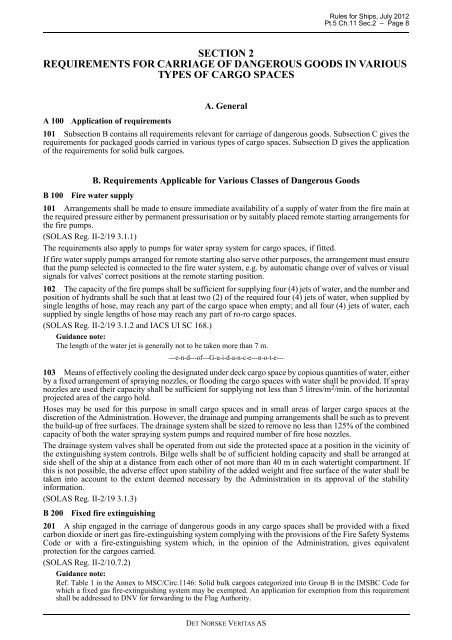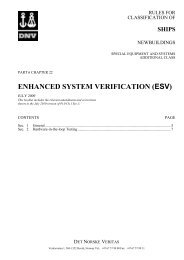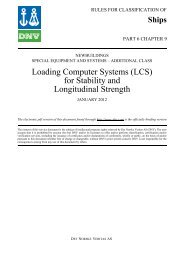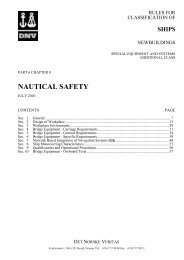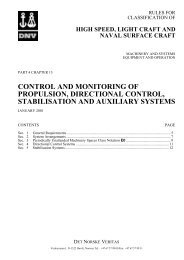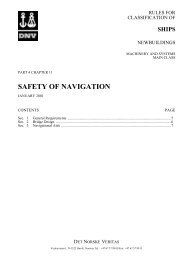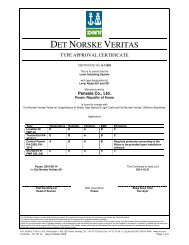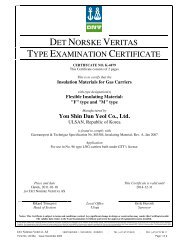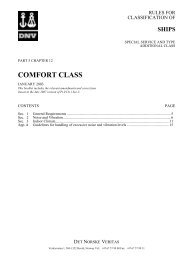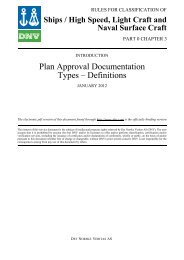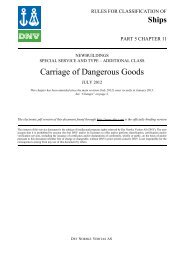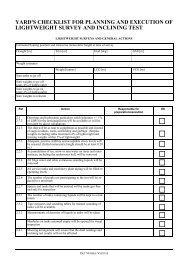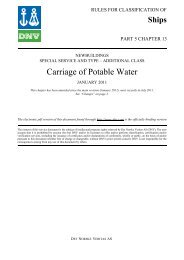Ship rules Pt.5 Ch.11 - Carriage of Dangerous Goods - DNV Exchange
Ship rules Pt.5 Ch.11 - Carriage of Dangerous Goods - DNV Exchange
Ship rules Pt.5 Ch.11 - Carriage of Dangerous Goods - DNV Exchange
You also want an ePaper? Increase the reach of your titles
YUMPU automatically turns print PDFs into web optimized ePapers that Google loves.
DET NORSKE VERITAS AS<br />
Rules for <strong>Ship</strong>s, July 2012<br />
<strong>Pt.5</strong> <strong>Ch.11</strong> Sec.2 – Page 8<br />
SECTION 2<br />
REQUIREMENTS FOR CARRIAGE OF DANGEROUS GOODS IN VARIOUS<br />
TYPES OF CARGO SPACES<br />
A. General<br />
A 100 Application <strong>of</strong> requirements<br />
101 Subsection B contains all requirements relevant for carriage <strong>of</strong> dangerous goods. Subsection C gives the<br />
requirements for packaged goods carried in various types <strong>of</strong> cargo spaces. Subsection D gives the application<br />
<strong>of</strong> the requirements for solid bulk cargoes.<br />
B. Requirements Applicable for Various Classes <strong>of</strong> <strong>Dangerous</strong> <strong>Goods</strong><br />
B 100 Fire water supply<br />
101 Arrangements shall be made to ensure immediate availability <strong>of</strong> a supply <strong>of</strong> water from the fire main at<br />
the required pressure either by permanent pressurisation or by suitably placed remote starting arrangements for<br />
the fire pumps.<br />
(SOLAS Reg. II-2/19 3.1.1)<br />
The requirements also apply to pumps for water spray system for cargo spaces, if fitted.<br />
If fire water supply pumps arranged for remote starting also serve other purposes, the arrangement must ensure<br />
that the pump selected is connected to the fire water system, e.g. by automatic change over <strong>of</strong> valves or visual<br />
signals for valves' correct positions at the remote starting position.<br />
102 The capacity <strong>of</strong> the fire pumps shall be sufficient for supplying four (4) jets <strong>of</strong> water, and the number and<br />
position <strong>of</strong> hydrants shall be such that at least two (2) <strong>of</strong> the required four (4) jets <strong>of</strong> water, when supplied by<br />
single lengths <strong>of</strong> hose, may reach any part <strong>of</strong> the cargo space when empty; and all four (4) jets <strong>of</strong> water, each<br />
supplied by single lengths <strong>of</strong> hose may reach any part <strong>of</strong> ro-ro cargo spaces.<br />
(SOLAS Reg. II-2/19 3.1.2 and IACS UI SC 168.)<br />
Guidance note:<br />
The length <strong>of</strong> the water jet is generally not to be taken more than 7 m.<br />
---e-n-d---<strong>of</strong>---G-u-i-d-a-n-c-e---n-o-t-e---<br />
103 Means <strong>of</strong> effectively cooling the designated under deck cargo space by copious quantities <strong>of</strong> water, either<br />
by a fixed arrangement <strong>of</strong> spraying nozzles, or flooding the cargo spaces with water shall be provided. If spray<br />
nozzles are used their capacity shall be sufficient for supplying not less than 5 litres/m2 /min. <strong>of</strong> the horizontal<br />
projected area <strong>of</strong> the cargo hold.<br />
Hoses may be used for this purpose in small cargo spaces and in small areas <strong>of</strong> larger cargo spaces at the<br />
discretion <strong>of</strong> the Administration. However, the drainage and pumping arrangements shall be such as to prevent<br />
the build-up <strong>of</strong> free surfaces. The drainage system shall be sized to remove no less than 125% <strong>of</strong> the combined<br />
capacity <strong>of</strong> both the water spraying system pumps and required number <strong>of</strong> fire hose nozzles.<br />
The drainage system valves shall be operated from out side the protected space at a position in the vicinity <strong>of</strong><br />
the extinguishing system controls. Bilge wells shall be <strong>of</strong> sufficient holding capacity and shall be arranged at<br />
side shell <strong>of</strong> the ship at a distance from each other <strong>of</strong> not more than 40 m in each watertight compartment. If<br />
this is not possible, the adverse effect upon stability <strong>of</strong> the added weight and free surface <strong>of</strong> the water shall be<br />
taken into account to the extent deemed necessary by the Administration in its approval <strong>of</strong> the stability<br />
information.<br />
(SOLAS Reg. II-2/19 3.1.3)<br />
B 200 Fixed fire extinguishing<br />
201 A ship engaged in the carriage <strong>of</strong> dangerous goods in any cargo spaces shall be provided with a fixed<br />
carbon dioxide or inert gas fire-extinguishing system complying with the provisions <strong>of</strong> the Fire Safety Systems<br />
Code or with a fire-extinguishing system which, in the opinion <strong>of</strong> the Administration, gives equivalent<br />
protection for the cargoes carried.<br />
(SOLAS Reg. II-2/10.7.2)<br />
Guidance note:<br />
Ref. Table 1 in the Annex to MSC/Circ.1146: Solid bulk cargoes categorized into Group B in the IMSBC Code for<br />
which a fixed gas fire-extinguishing system may be exempted. An application for exemption from this requirement<br />
shall be addressed to <strong>DNV</strong> for forwarding to the Flag Authority.


